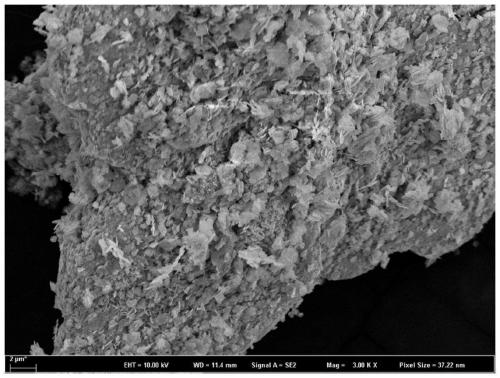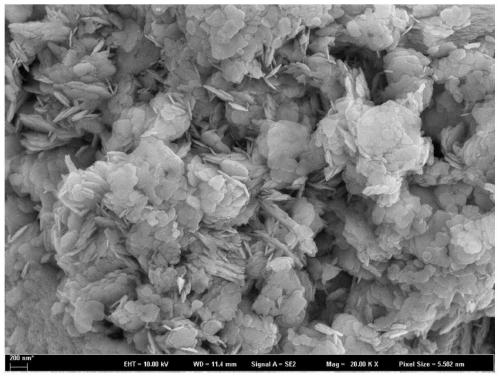Heterostructure photocatalyst for enhancing visible light response and preparation method thereof
A photocatalyst and heterojunction technology, applied in chemical instruments and methods, physical/chemical process catalysts, inorganic chemistry, etc., can solve problems such as affecting visible light absorption, reduce recombination rate, improve stability, and improve photocatalytic activity. Effect
- Summary
- Abstract
- Description
- Claims
- Application Information
AI Technical Summary
Problems solved by technology
Method used
Image
Examples
Embodiment 1
[0017] (1) White CaBi 2 o 4 Preparation of powder materials. Weigh 1.3573gCa(NO 3 ) 2 4H 2 O and 5.5844gBi(NO 3 ) 3 ·5H 2 O, Ca(NO 3 ) 2 4H 2 O was dissolved in 50mL deionized water to make a transparent solution, and then Bi(NO 3 ) 3 ·5H 2 O was dissolved in 50mL of dilute nitric acid solution just prepared, put the above two transparent solutions into a 200mL beaker and mix them, and stir for 30min to make them evenly mixed. Take a 500mL beaker, add 100mL deionized water as the bottom solution, mix the solution with 3mol / L ammonia water (NH 3 ·H 2 O) The two solutions are titrated together in the bottom solution, while stirring continuously to mix the precipitation reactants evenly, so that the pH of the reaction solution is kept at about 8, and the precipitation suspension obtained after the titration is completed is continued to stir and age for 30 minutes. Then use a centrifuge to separate the solid from the liquid, and wash the resulting white precipitate ...
Embodiment 2
[0021] (1) White CaBi 2 o 4 Preparation of powder materials. Weigh 1.3566gCa(NO 3 ) 2 4H 2 O and 5.5812gBi(NO 3 ) 3 ·5H 2 O, Ca(NO 3 )2 4H 2 O was dissolved in 50mL deionized water to make a transparent solution, and then Bi(NO 3 ) 3 ·5H 2 O was dissolved in 50mL of dilute nitric acid solution just prepared, put the above two transparent solutions into a 200mL beaker and mix them, and stir for 30min to make them evenly mixed. Take a 500mL beaker, add 100mL deionized water as the bottom solution, mix the solution with 3mol / L ammonia water (NH 3 ·H 2 O) The two solutions are titrated together in the bottom solution, while stirring continuously to mix the precipitation reactants evenly, so that the pH of the reaction solution is kept at about 8, and the precipitation suspension obtained after the titration is completed is continued to stir and age for 30 minutes. Then use a centrifuge to separate the solid from the liquid, and wash the resulting white precipitate wi...
Embodiment 3
[0025] (1) White CaBi 2 o 4 Preparation of powder materials. Weigh 1.3530g Ca(NO 3 ) 2 4H 2 O and 5.5856gBi(NO 3 ) 3 ·5H 2 O, Ca(NO 3 ) 2 4H 2 O was dissolved in 50mL deionized water to make a transparent solution, and then Bi(NO 3 ) 3 ·5H 2 O was dissolved in 50mL of dilute nitric acid solution just prepared, put the above two transparent solutions into a 200mL beaker and mix them, and stir for 30min to make them evenly mixed. Take a 500mL beaker, add 100mL deionized water as the bottom solution, mix the solution with 3mol / L ammonia water (NH 3 ·H 2 O) The two solutions are titrated together in the bottom solution, while stirring continuously to mix the precipitation reactants evenly, so that the pH of the reaction solution is kept at about 8, and the precipitation suspension obtained after the titration is completed is continued to stir and age for 30 minutes. Then use a centrifuge to separate the solid from the liquid, and wash the resulting white precipitate...
PUM
 Login to View More
Login to View More Abstract
Description
Claims
Application Information
 Login to View More
Login to View More - R&D
- Intellectual Property
- Life Sciences
- Materials
- Tech Scout
- Unparalleled Data Quality
- Higher Quality Content
- 60% Fewer Hallucinations
Browse by: Latest US Patents, China's latest patents, Technical Efficacy Thesaurus, Application Domain, Technology Topic, Popular Technical Reports.
© 2025 PatSnap. All rights reserved.Legal|Privacy policy|Modern Slavery Act Transparency Statement|Sitemap|About US| Contact US: help@patsnap.com


